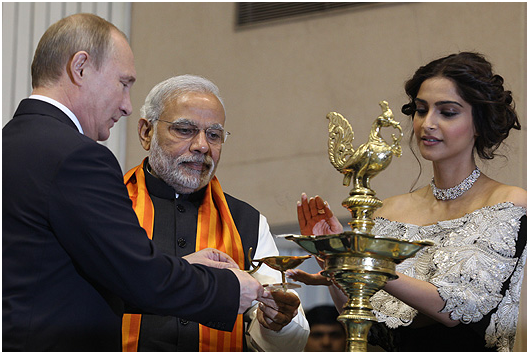India-Russia: 'Make In India' On Paper, Not In Reality
PM Modi and President Putin with actor Sonam Kapoor in Delhi earlier in December

NEW DELHI: Military co-operation was highlighted as the primary focus of Prime Minister Narendra Modi’s recent Moscow trip, but the joint statement reflected this critical aspect only in passing.
It mentioned the Inter-Governmental Agreement (IGA) to locally licence-build some 200 Kamov Ka-226T light utility helicopters (LUHs), disingenuously touting it as the first major ‘Make in India’ project in the military sector.
But the reality of the proposed helicopter programme, decided upon 12 months ago, during President Vladimir Putin’s daylong Delhi trip, is vastly different from the official line.
The programme includes the direct import of around 50 platforms to meet the Indian military’s long-delayed requirements, as replacements for the fleet of obsolete Chetak (Aerospatiale Alouette III) and Cheetah (Aerospatiale SA-315B).
Thereafter, the designated Indian manufacturer that will partner Kamov in building the helicopters will only gradually increase their indigenous content, to a maximum 30 per cent.
In short, 70 per cent of the helicopter-including its French Turbomeca Arrius 2G1 engine manufactured by France’s Safran, would be imported, in knocked down form as part of PM Modi’s much touted ‘Make in India’ initiative.
There was no indication, however, during PM Modi’s visit whether the Indian partner for the Ka-226T helicopters would be the state-owned Hindustan Aeronautics Limited (HAL) or the privately owned Reliance Defence. But industry sources indicated that HAL with its vast experience in licence-building, designing and series producing a range of helicopters, could well be designated the principal Ka-226T integrator.
Ancillary units like Reliance Defence, amongst others, would be component and sub-assembly suppliers.
There was also no mention in the joint statement of the S-400 Triumf long-range air defence system, approved by the Cabinet Committee on Security (CCS) on 18 December, in anticipation of the PM’s forthcoming Moscow trip nor the crucial Fifth Generation Fighter Aircraft (FGFA) programme.
Also absent from the joint statement was the proposed lease of a second Russian nuclear-powered attack submarine (SSN) for 10 years.
International treaties forbid the sale of SSN/ballistic missile submarines (SSBNs), but leases are permitted, provided the boats are not fitted with missiles with ranges of over 300km.
Official sources said the SSN lease, which was to have been progressed during Modi’s trip, has been deferred following problems over cost and technology transfer issues.
For over three years both sides had been negotiating to lease a follow-on SSN for the Indian Navy (IN), which earlier was to have been the Iribis, a Shchuka-B (Akula)-class boat, similar to INS Chakra, that India leased in 2012 for 10 years for around $960 million.
The Iribis was abandoned, half-completed, after the Soviet Unions break-up in the early 1990’s and India was to have financed its completion.
But in recent months the IN decided to lease the more advanced Yasen-class SSN, one of which was to have been specially built for India.
According to this proposal, IN technicians would have worked alongside the Russians and upon returning home, would employ the expertise gained to indigenously design and build six SSN’s over 10-15 years, under a Rs 1,000 crore programme approved by the CCS in February.
But differences over the SSN’s price led to Russia offering the IN a retrofitted Akula-class SSN instead. The IN remains unwilling to accept this proposal and is still engaged in trying to persuade the Russians to reconsider its offer.
Meanwhile, Russia, India’s principal defence equipment supplier for almost five decades, is miffed with New Delhi for diversifying its military equipment procurements from other countries like France, Israel and the US.
This peeve had resulted in Moscow agreeing to sell Pakistan at least four Mi-35 ‘Hind’ attack helicopters and opening negotiations on supplying the Pakistan Air Force Sukhoi Su-35 fighters.
But despite these irritations and differences, Russia, for the foreseeable future, will remain India’s main defence equipment provider.
India’s military operates a preponderance of Russian military platforms and equipment and assorted missiles and ordnance that will remain in service for at least another 25-30 years, if not longer and serve to perpetuate defence ties.
The bulk of the Indian Air Force’s 34-odd fighter squadrons comprise Russian aircraft including some 172 multi-role Su-30MKIs, whose numbers will rise to 272 by 2017, making it the single largest fighter type in the force.
Over the next few years, manufacturers Irkut Corporation will upgrade these fighters to 'Super Sukhoi' standards, by fitting them with 5th generation features and rendering them capable of delivering a heavier weapons load.
This will include the Indo-Russian developed BrahMos cruise missile with a 292 km range.
The IAF continues to operate a large number of Russian military transports and varied helicopters, some of which were being upgraded.
India is also an equal partner with Russia in the troubled and long-delayed USD11 billion development of the Fifth Generation Fighter Programme (FGFA) that is based on the Russian Air Force’s Sukhoi T-50 PAK-FA platform.
India, which has so far paid USD295 million for the preliminary FGFA design, plans acquiring around 60-70 FGFA, but the details are mired in differences.
Besides, Russia is the only P5 country willing to supply India strategic platforms and knowhow.
Russian scientists had helped India miniaturise the 83MW pressurised light water reactor that powers INS Arihant, the INs first locally designed SSBN, which began sea acceptance trials last December and whose commissioning is imminent.
They are similarly collaborating on the three add-on SSBNs under construction at the secretive Ship Building Centre at Vishakapatnam.



